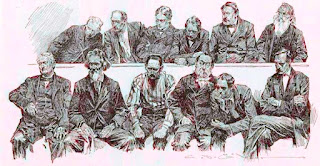K. Crosby, Senior Lecturer in Law, Newcastle Law School, has posted several articles on the jury in the United Kingdom England and the United States.
Arguments: Jury lawfinding debates in 1842 New Hampshire, published in A Cultural History of Law, vol 5: A Cultural History of Law in the Age of Reform 1820-1920, ed. Gary Watt and Ian Ward (Bloomsbury, 2019), 91-110:
Abolishing Juries of Matrons, Oxford Journal of Legal Studies 39 (2019): 259-284:The Age of Reform 1820-1920 witnessed a significant move from popular constitutionalism, rooted in traditions of participatory democracy, to a much more exclusive, judge-centric, view of the law (Kramer 2004). This chapter explores this general development through detailed consideration of the particular case of Pierce v State (1843) 13 NH 536. The importance of the Pierce case, which concerned a conflict between the respective powers of judge and jury, has long been acknowledged. In the Supreme Court’s 1895 rejection of jury lawfinding, it was one of the most influential cases cited by Harlan J; and in more recent academic literature its final appellate judgments have been described as “two of the most well-reasoned discussions opposing the jury’s right to judge the law” (Conrad 1998: 69). But despite its foundational status within the judicial rejection of the jury lawfinding argument, little is known about the way the judgments were formed. The present chapter relies on contemporary newspaper reports and pamphlets to fills this gap in the cultural history of the case. In so doing, we will shed light on the popular cultural reception of constitutional developments in the Age of Reform.
C.D. Gibson "The Jury" (1906) (NYPL)
This article explores the last 50 years of the jury of matrons, a special type of jury used in England and Wales until the middle of the 20th century to secure reprieves for pregnant women sentenced to death. Despite claims that the jury of matrons had fallen out of use by the middle of the Victorian era, such juries were used in over 10% of cases in which women were sentenced to death during the first three decades of the 20th century. Exploring the circumstances in which the jury of matrons was abolished in 1931 can help us see how various important parts of the contemporary criminal justice system of England and Wales developed. In particular, it allows us to see in greater detail how ideas of the jury and of capital punishment were changing at this time, and how important political networks were in securing legislative reforms.Keeping Women off the Jury in 1920s England and Wales, Legal Studies 37 (2017): 695-717:
The Sex Disqualification (Removal) Act 1919 ended the prohibition on female jurors. This did not mean that English and Welsh juries became representative institutions overnight, however: the property qualifications ensured that juries were still drawn from the top few per cent of the local population; and the 1919 Act expressly permitted trial judges to order single-sex juries where the nature of the evidence required it. The continued existence of peremptory challenges allowed defendants in felony trials to exclude women from their juries whenever they preferred to be tried only by men. Finally, some judges permitted female jurors to excuse themselves from particular trials if they so desired. This paper explores the effects these factors had on the practical enjoyment of the female jury franchise after the passing of the 1919 Act. It finds that the picture is remarkably localised: rates of women serving on juries were very different for the five assize circuits for which adequate records exist (Midland, Oxford, South Eastern, South Wales and Western). By exploring these issues, this paper reveals how flexible the female jury franchise was in its early years, and shows how important local differences were in keeping women off the jury.--Dan Ernst
